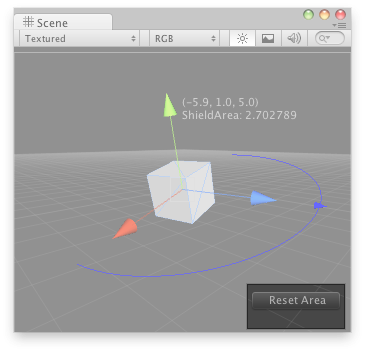Parameters
| position | The position and size of the 2D GUI area. |
Description
Begin a 2D GUI block inside the 3D handle GUI.
Begin a 2D GUI block on top of the current handle camera.
GUI in the Scene View.
See Also: Handles.EndGUI.
To use this example, place this script in the Assets/Editor folder:
#pragma strict @CustomEditor(DummyButton) public class DummyButtonHandleEditor extends Editor { public var arrowSize: float = 1; function OnSceneGUI() { var t: DummyButton = target as DummyButton; Handles.color = Color.blue; Handles.Label(t.transform.position + Vector3.up * 2, t.transform.position.ToString() + "\nShieldArea: " + t.shieldArea.ToString()); Handles.BeginGUI(); GUILayout.BeginArea(new Rect(Screen.width - 100, Screen.height - 80, 90, 50)); if (GUILayout.Button("Reset Area")) t.shieldArea = 5; GUILayout.EndArea(); Handles.EndGUI(); Handles.DrawWireArc(t.transform.position, t.transform.up, -t.transform.right, 180, t.shieldArea); t.shieldArea = Handles.ScaleValueHandle(t.shieldArea, t.transform.position + t.transform.forward * t.shieldArea, t.transform.rotation, 1, Handles.ConeCap, 1); } }
using UnityEngine; using UnityEditor;
[CustomEditor( typeof( DummyButton ) )] public class DummyButtonHandleEditor : Editor { public float arrowSize = 1;
void OnSceneGUI( ) { DummyButton t = target as DummyButton;
Handles.color = Color.blue; Handles.Label( t.transform.position + Vector3.up * 2, t.transform.position.ToString( ) + "\nShieldArea: " + t.shieldArea.ToString( ) );
Handles.BeginGUI( ); GUILayout.BeginArea( new Rect( Screen.width - 100, Screen.height - 80, 90, 50 ) );
if( GUILayout.Button( "Reset Area" ) ) t.shieldArea = 5;
GUILayout.EndArea( ); Handles.EndGUI( );
Handles.DrawWireArc( t.transform.position, t.transform.up, -t.transform.right, 180, t.shieldArea );
t.shieldArea = Handles.ScaleValueHandle( t.shieldArea, t.transform.position + t.transform.forward * t.shieldArea, t.transform.rotation, 1, Handles.ConeCap, 1 ); } }
...and attach this script to the object you'd like to attach the handles to:
#pragma strict @ExecuteInEditMode public class DummyButton extends MonoBehaviour { public var shieldArea: float = 5; }
using UnityEngine;
[ExecuteInEditMode] public class DummyButton : MonoBehaviour { public float shieldArea = 5; }